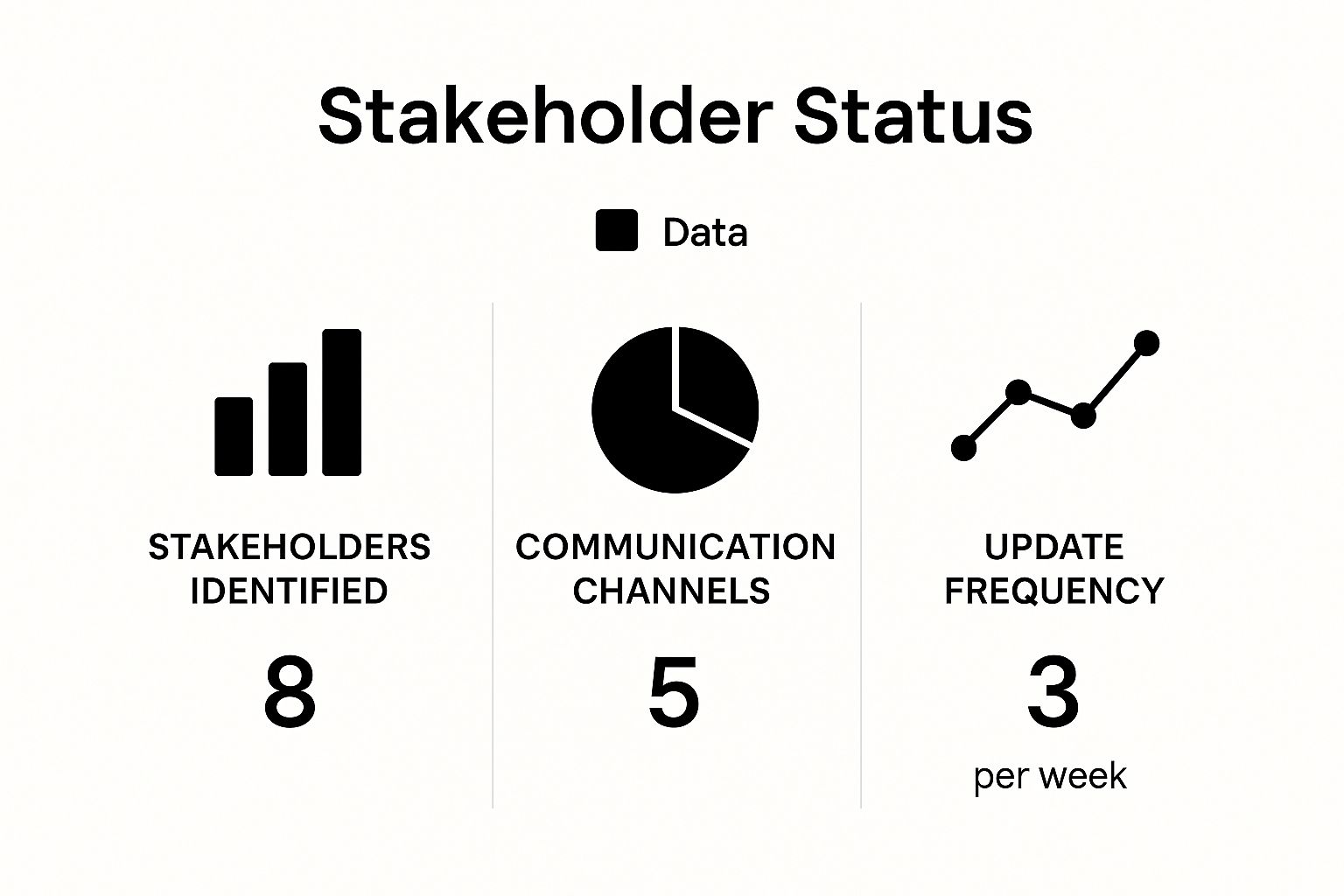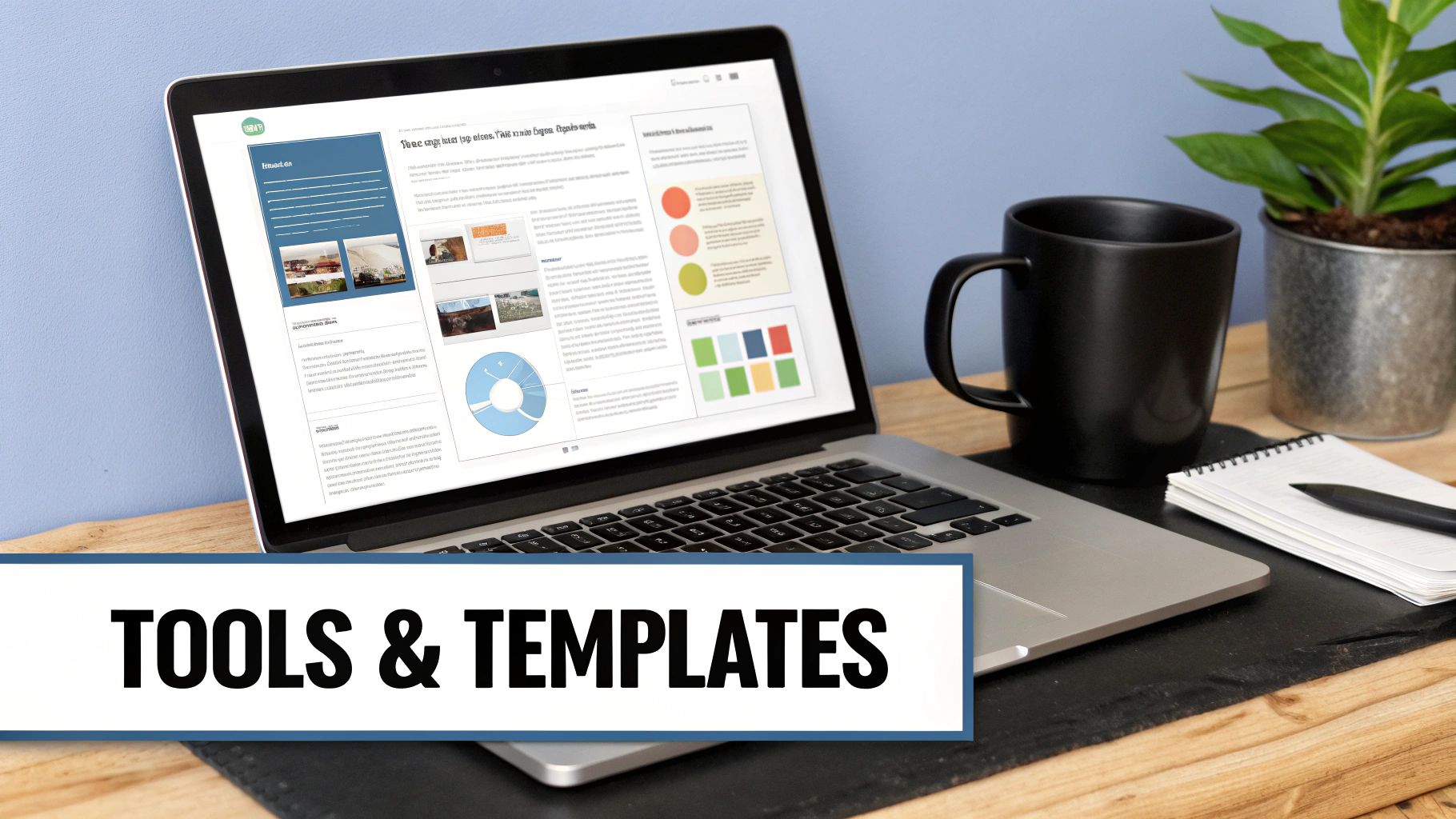Let's be real. Most project failures aren't caused by one massive, explosive event. They die a slow death, fueled by a thousand tiny communication cuts.
A marketing team launches a campaign with outdated product specs. A key executive misses a critical budget update buried in a massive email chain. Sound familiar? We’ve all been there.
This is exactly why a solid project communication plan template isn't just a "nice-to-have" document. It’s a mission-critical asset. This isn't about adding more meetings to everyone's calendar; it's about making every single interaction count.
Why a Communication Plan Is Your Project’s Secret Weapon

A well-crafted plan creates a unified system. It manages expectations, aligns diverse teams from tech to marketing, and—most importantly—establishes a single source of truth that everyone can rely on.
Think of it as the central command center for your entire project. Instead of just reacting to fires as they pop up, you're proactively stamping out the embers before they can ever ignite. It sets clear rules of engagement, so everyone knows exactly where to find information and who to ping with specific questions.
"Without a plan, communication is just noise. With one, it becomes your most powerful tool for steering a project toward success, ensuring everyone is rowing in the same direction."
The Real Cost of Poor Communication
When communication breaks down, the consequences are immediate and expensive. Scope creep becomes almost a guarantee as stakeholders chime in with feedback through scattered channels, leading to unapproved changes. Deadlines get blown because dependencies between teams were never made clear.
I’ve seen this happen firsthand on a software development project. The design team was sharing mockups via email, developers were tracking their own tasks in a separate system, and the client was dropping feedback in random video calls. A crucial client comment about a key feature got lost in the shuffle. The result? Weeks of rework, a busted budget, and a very unhappy client.
A structured plan would have designated a specific channel and format for all feedback, stopping this costly mistake before it ever happened. Honestly, learning how to effectively manage creative projects starts with getting this kind of structured communication right.
From Chaos to Clarity
A well-designed communication plan is your roadmap from chaos to clarity. It’s what helps you improve overall workplace communication in a tangible way. It transforms scattered, ad-hoc updates into a predictable and efficient flow of information. This proactive approach pays off in a few key ways:
- Boosts Stakeholder Confidence: When stakeholders get regular, relevant updates, their confidence in the project—and you—skyrockets. They feel informed and valued, not left in the dark.
- Reduces Rework and Waste: Getting the right information to the right people at the right time is the fastest way to minimize misunderstandings and the painful rework that follows.
- Empowers Team Members: A clear plan gives your team autonomy. It defines their communication responsibilities, cuts down on confusion, and lets them focus on what they do best.
And the data doesn't lie. Teams with defined communication protocols complete projects roughly 28% faster than those without. This boost comes from knowing who the stakeholders are, having scheduled updates, and setting clear roles. For instance, just doing a proper stakeholder analysis can increase success rates by 35%, and picking the right communication channels can improve message retention by a staggering 45%. You can dig into more of these findings on project communication plans from 6sigma.us.
The Anatomy of a High-Impact Communication Template
A truly effective communication plan isn't just a list of meetings and emails. It’s a living document, a strategic guide that anticipates what people need to know, sets clear expectations, and creates a steady, predictable rhythm for the entire project.
Think about the difference. A basic plan might just say, "Weekly Update Email." A great one gets specific: a weekly email to executive sponsors, sent every Friday by 4 PM, containing a budget burndown chart, a list of key risks, and a clear snapshot of progress against milestones. That level of detail is what kills ambiguity and keeps everyone on the same page.
So, where do you start? The real foundation of a strong plan is its objectives. Before you even think about how you'll communicate, you have to nail down why. And no, "keep everyone informed" doesn't cut it. Your goals need to be specific, measurable, and tied directly to project success.
Define Clear Communication Objectives
Your communication objectives are the "mission statements" for your information flow. They give every single email, meeting, and report a clear purpose and direction. Without them, you’re just making noise.
Here are a few examples of what strong, action-oriented objectives look like in the real world:
- For Timely Feedback: Guarantee all creative stakeholders provide consolidated feedback on design mockups within 48 hours of submission.
- For Executive Alignment: Provide executive sponsors with a concise weekly summary of budget status and milestone progress, ensuring there are absolutely no surprises.
- For Technical Clarity: Make sure the development team has a clear, documented channel for asking questions about technical specs and getting answers within one business day.
Setting these objectives up front is a game-changer. It turns your communication from a reactive chore into a proactive strategy. It also gives you a benchmark to measure against so you can tell if your efforts are actually working.
Before we dive into the other components, it's worth laying out the essentials in a clear format. This is the bedrock of your template.
Here’s a simple table that breaks down the must-have elements for any solid communication plan.
Essential Components of a Communication Plan
| Component | Purpose | Example |
|---|---|---|
| Objective | The specific goal of the communication. | To secure final approval on the V2 design from the client by EOD Friday. |
| Audience | Who needs to receive this information? | Client-side Project Lead, Head of Marketing. |
| Key Message | The single most important takeaway. | The V2 design incorporates all feedback and is ready for development. |
| Channel | The tool or method for delivery. | Formal email with a PDF attachment, followed by a link in the shared Slack channel. |
| Frequency | How often the communication happens. | One-time for this specific approval. |
| Owner | Who is responsible for sending it? | Design Team Lead. |
This structure forces you to be intentional about every piece of information you share, which is exactly the point.
Conduct Meaningful Stakeholder Analysis
Once you know why you're communicating, you need to know who you're talking to. Far too often, stakeholder analysis is just a list of names and titles. To make your plan genuinely effective, you have to go deeper and understand each person's actual relationship to the project.
For every individual or group, your template should let you capture:
- Their Influence: How much power do they have to impact project outcomes? (High, Medium, Low)
- Their Interest: How invested are they in the project's success? (High, Medium, Low)
- Their Information Needs: What, specifically, do they need to know? A CFO cares about ROI and budget. A lead engineer cares about API documentation and technical dependencies.
- Their Preferred Channel: Do they live in Slack, or will they only pay attention to a formal email?
A powerful stakeholder analysis tells you not just who to talk to, but how to talk to them. It's the difference between just broadcasting a message and actually ensuring it’s received and understood.
With projects getting more complex and teams often including a mix of freelancers, clients, and even legal departments, this kind of analysis is non-negotiable. It's how you coordinate diverse groups and keep things transparent. You can learn more about this in a great post on how communication templates build project success on TextMagic.
Craft Tailored Key Messages
Okay, you’ve got your objectives set and your stakeholders mapped out. The final piece of the puzzle is crafting your key messages. This isn’t about writing every single email in advance—that would be insane. It’s about defining the core, consistent information that each audience group needs to hear.
Your template should make it easy to connect stakeholders to specific message types. For example:
- Executives get: High-level summaries, milestone completion reports, and budget forecasts.
- The Project Team gets: Detailed task assignments, daily stand-up notes, and technical clarifications.
- Clients get: Progress demos, milestone updates, and clear timelines for upcoming deliverables.
This part of the plan ensures every communication is relevant and, just as importantly, respects the recipient's time. A well-structured plan often pulls directly from your initial project documents. For instance, the key messages for your creative team can be lifted right out of your initial brief. Our guide on using creative brief templates has some great insights on how to lock down this foundational messaging from day one.
By really nailing these three elements—objectives, stakeholders, and messages—you build a communication plan template that’s more than just a document. It becomes a powerful engine for alignment, clarity, and project momentum.
Crafting Your Reusable Communication Template

Alright, time to roll up our sleeves and build something you can actually use. We're not making some rigid, boring document that's destined for a digital dustbin. We're creating a flexible, reusable project communication plan template that will become one of the most valuable assets in your project management toolkit.
This isn't just about listing meetings. It's about designing a strategic framework you can quickly adapt for any project that comes your way.
The whole thing starts with your audience. I've learned this the hard way: any communication strategy that doesn't start with a deep dive into stakeholder analysis is doomed. Before you draft a single email, you have to know exactly who you're talking to, what they care about, and why they should listen.
Start with Detailed Stakeholder Mapping
Let's ground this in a real-world scenario to show you what I mean. Imagine you're managing a new software launch. Your stakeholder list is going to be all over the place, from investors watching the bottom line to the customer support team who will be on the front lines. A simple list of names and titles just won't do.
You need to slice and dice that list based on each person's relationship to the project. For our software launch, the groups might look something like this:
- Executive Leadership: They need the 30,000-foot view. Think high-level progress updates and ROI metrics. Their interest is purely strategic, and their influence is sky-high.
- Development Team: These folks are in the trenches. They need detailed technical specs, bug reports, and crystal-clear sprint goals. Their focus is operational.
- Marketing Team: They need the juicy stuff—key messaging points, launch dates, and detailed target audience profiles to work their magic.
- Beta Testers (External): This group needs clear instructions, a simple way to give feedback, and updates on when you've fixed the bugs they found.
- End-Users (Post-Launch): After the big day, this group will need tutorials, support docs, and announcements about slick new features.
When you map out your stakeholders like this, it becomes immediately obvious that a one-size-fits-all weekly email is a terrible idea. Each group has completely different needs, and your plan has to speak to them directly.
Aligning Goals with Specific Activities
Once you know who you're talking to, the next step is connecting their needs to actual, tangible communication activities. This is where the magic happens, turning your strategy into a concrete action plan. Every single meeting, email, or report must have a clear, undeniable purpose.
Sticking with our software launch, you can start matching activities to what each audience needs:
- Goal: Keep developers aligned on daily priorities.
- Activity: A quick 15-minute daily stand-up on Slack. No fluff, just facts.
- Goal: Give executives a concise budget and timeline overview.
- Activity: A bi-weekly automated report pulled directly from your project management tool, delivered to their inbox.
- Goal: Get actionable feedback from beta testers.
- Activity: A dedicated feedback portal (like Jira or a simple form) and a weekly digest summarizing key issues for the dev team.
This alignment is your best defense against the "meeting for the sake of meeting" disease. Every touchpoint is now tied directly to a project outcome, making your plan incredibly efficient. It’s also a great way to spot communication gaps before they become massive headaches.
A great project communication plan template doesn’t just schedule interactions; it engineers them. It ensures the right information reaches the right people through the right channel at precisely the right moment.
Building the Core Template Structure
Now you can build the actual structure in a spreadsheet or your favorite project management tool. This is the heart of your reusable asset. At a minimum, your template should have columns that capture the who, what, how, when, and why for every communication activity.
To get going quickly, you can check out and download the best communication plan template for a solid foundation, then tweak it to fit your team's style.
Here’s a simple but powerful structure I've used on countless projects:
| Column | Description |
|---|---|
| Audience | Who is receiving this communication? (e.g., Executive Sponsors) |
| Key Message | What is the core takeaway? (e.g., "Phase 1 is complete and on budget.") |
| Channel | How will the message be delivered? (e.g., Email, Slack, In-Person Meeting) |
| Frequency | How often will this happen? (e.g., Weekly, Daily, As-Needed) |
| Owner | Who is responsible for sending it? (e.g., Project Manager) |
A simple table like this forces clarity and accountability. It takes your plan from a vague idea to a clear set of instructions that anyone on the project team can understand and execute. One of the biggest hidden benefits here is that it stops misunderstandings that often lead to chaos. To get ahead of that particular problem, it’s worth understanding how to manage scope creep from day one.
By investing the time to craft a flexible and detailed template, you’re not just planning for one project. You’re building a scalable system for success that will pay off on every single initiative you tackle from here on out.
Adapting Your Template for Any Project Type
Let's be real: a single, rigid communication plan is a recipe for disaster. What works for a fast-and-furious software update will absolutely tank a long-term construction project. That's not a failure of planning; it's just reality.
The true magic of a project communication plan template isn't its strictness—it's how easily you can mold it. Think of your template as a solid starting point, a base recipe. Sometimes you’ll need to add a little spice for a fast-moving project; other times, you’ll strip it back to the essentials for something more straightforward. The goal is to reshape your core framework to match the unique rhythm of the work.
Adjusting for Different Methodologies
Your project's methodology is the first big clue. Is it an Agile software project? Then your communication needs to be all about speed and frequency. The plan has to be built around daily stand-ups on Slack, real-time bug tracking in Jira, and bi-weekly sprint demos. It's all about constant, informal feedback loops to keep things moving.
Now, flip that script for a massive construction project running on a Waterfall approach. The vibe is completely different. Here, formality and documentation are everything. Your plan needs to demand official weekly progress reports, meticulously documented change orders for investors, and scheduled on-site meetings with regulators. The focus is on creating a clear paper trail and getting official sign-offs at every stage.
The best project managers don't force a project into a communication plan; they shape the communication plan to serve the project. Adaptability is the key to maintaining control and clarity, no matter the context.
A marketing campaign usually lands somewhere in the middle. You need a plan that can handle quick, creative back-and-forths with the team on a tool like Asana or Trello, while also providing structured updates for media buyers and formal progress reports for clients. Juggling those different streams is where top-tier creative operations management proves its worth.
Thankfully, you don't have to start from scratch. The web is full of free project communication plan templates that make this kind of customization a breeze. Many of them, like the excellent resources on Smartsheet's project communication page, use a matrix-style layout. This helps you easily map communication types (meetings, emails, reports) to specific audiences and frequencies, giving you a flexible-yet-standardized framework.
Tailoring Your Template by Project Type
Let's break down how communication needs really shift from one project to the next. The groups you talk to, the channels you use, and how often you send updates can vary wildly.

As you can see, a construction project has way more stakeholder groups to manage and needs more frequent updates. A marketing campaign, on the other hand, might use a wider variety of channels to coordinate all the moving parts.
To get really practical, let’s look at how you'd tweak your template for two very different worlds: an Agile software build and a traditional Waterfall construction project.
Template Customization by Project Type
Here’s a side-by-side look at how you’d adjust your communication strategy based on the project's methodology.
| Communication Element | Agile Project Example | Waterfall Project Example |
|---|---|---|
| Primary Audience | Internal development team, product owner, scrum master. | External investors, regulatory bodies, contractors, the client. |
| Key Channels | Slack for daily updates, Jira for task tracking, Zoom for sprint demos. | Formal emails for official notices, printed reports for investors, on-site meetings. |
| Update Frequency | Daily stand-ups, bi-weekly sprint reviews. | Weekly progress reports, monthly stakeholder briefings, ad-hoc change orders. |
| Tone & Formality | Informal, collaborative, and to the point. | Formal, documented, and highly detailed. |
This comparison makes it crystal clear: your base template is just a launchpad. By thoughtfully adjusting who you're talking to, how you're talking to them, and how often, you turn a generic document into a precise, powerful tool. It’s this strategic customization that truly separates the good project managers from the great ones.
Alright, you've gone through the hard work of building out a brilliant project communication plan template. The columns are set, the stakeholder analysis is on point, and your objectives are perfectly clear.
But let's be honest, a plan just sitting in a folder is nothing more than a document. The real magic—and the real value—happens when you make it a living, breathing part of your project.

Putting your plan into action isn't about firing off an email and hoping for the best. It's about a deliberate rollout, consistent upkeep, and having the confidence to guide conversations, especially when they get a little rocky. This is the practical, in-the-trenches advice that turns your template from a simple doc into a genuine driver of project success.
Secure Early Buy-In During Kickoff
Your project kickoff meeting is the prime time to introduce your communication plan. Don't just gloss over it as another piece of paperwork. You have to sell its benefits.
Show everyone—from the execs down to the junior team members—how this plan will actually make their lives easier. We're talking less noise, clearer expectations, and keeping everyone on the same page. Frame it as the solution to common project headaches, like buried emails and those endless "just checking in" pings.
When stakeholders see it as a tool for their own efficiency, not just another bureaucratic hoop to jump through, they'll get on board much faster.
Treat your communication plan like a product you’re launching to your team. Your goal during kickoff is to get every single stakeholder to "buy" it. Their understanding and agreement are the foundation for the plan’s success.
This initial buy-in really sets the tone for the entire project. When your team sees you’re serious about sticking to the plan from day one, they’ll follow your lead. This early adoption is a huge deal. If you're looking for more ways to get your projects started on the right foot, take a look at these 8 critical project success factors for 2025.
Treat the Plan as a Living Document
Here’s a classic mistake I see all the time: treating the communication plan as a "set it and forget it" task. Projects are messy and unpredictable. Timelines slip, stakeholders come and go, and curveballs get thrown your way. Your communication plan has to be able to roll with the punches.
I recommend scheduling regular, quick check-ins on the plan at key project milestones. Good moments for a review include:
- At the end of a major phase or sprint.
- Whenever a new key stakeholder joins the project.
- If you have a significant change in scope or budget.
During these reviews, ask some simple but powerful questions. Are our weekly reports still useful? Is the daily stand-up format working? Are we actually reaching the marketing team through the right channels? This kind of ongoing adjustment keeps your plan relevant and effective from start to finish.
Automate and Navigate Difficult Conversations
Modern project management tools are your best friend here. Platforms like Asana, Monday.com, or Jira can automate a ton of this for you, like sending out status reports on a schedule. This not only frees up your time but also ensures the updates are consistent and reliable.
But you can't automate everything. Tough conversations are inevitable, and your plan should be your guide for navigating them.
Tips for Tough Talks
- Delivering Bad News: When a deadline is about to be missed or the budget is in trouble, don't try to hide it. Use the channel you designated for high-priority updates (this is often a direct call or a small, focused meeting). Be upfront, explain the impact, and always come prepared with a proposed solution or at least a mitigation plan.
- Managing Conflicting Demands: What happens when two stakeholders give you contradictory feedback? Use the plan to bring them together. Schedule a meeting with a crystal-clear agenda: "Resolve conflicting feedback on Feature X." This structured approach cuts out the back-channel noise and forces a clear path forward.
By implementing your plan with purpose, treating it as a dynamic guide, and using it to steer through even the toughest moments, you'll find it becomes one of your most valuable tools for getting things done.
Got Questions About Your Communication Plan?
So you’ve got your project communication plan template all filled out. That's a great start. But let's be real—a plan on paper is one thing. Actually using it day-to-day when things get messy is another beast entirely.
You're going to hit snags. Questions will pop up. It’s totally normal. Let's walk through some of the most common hurdles I see project managers face and get you some straight answers. Think of this as the "in the trenches" guide to keeping your plan from becoming just another ignored document.
"How Often Should I Update This Thing?"
Your communication plan isn't a "set it and forget it" artifact. If you treat it that way, it'll be obsolete before your first project phase is even done. It needs to be a living, breathing guide that adapts right along with your project.
So, when should you dust it off for a review? There are a few key moments:
- After a big milestone: When you wrap up a sprint or a major phase, it's the perfect time to ask, "Did our communication flow work? What felt clunky?"
- When something major changes: Scope creep? Budget cuts? New executive sponsor? Any significant shift means your communication strategy needs a tune-up.
- A quick monthly health check: Even if things are sailing smoothly, a quick 15-minute review each month keeps the plan relevant and top-of-mind. It’s good project hygiene.
Staying on top of this prevents your plan from gathering digital dust and ensures it’s actually helping, not hindering.
"Isn't This the Same as a Project Charter?"
Nope. It's an easy mistake to make, but they have very different jobs.
Think of the project charter as your project’s official birth certificate. It’s a high-level document that gives the project the green light. It answers the big questions: What are we doing, and why are we doing it? It outlines the main goals, the scope, and who the key players are.
The project communication plan is the tactical playbook that comes next. It’s all about the how, when, what, and who of information sharing. It doesn't authorize the project; it dictates how everyone will talk to each other while the project is underway.
The charter says, “We’re building a new app.” The communication plan says, “And here’s exactly how the devs, marketers, and execs will stay in the loop while we do it.”
"How Do I Get Stakeholders to Actually Follow the Plan?"
Ah, the classic challenge. You can craft the most beautiful, logical plan in the world, but it’s worthless if nobody uses it. Getting people on board isn’t about emailing them a doc and hoping for the best.
The secret is all about the rollout. Don't just send it—sell it.
Introduce your plan with genuine enthusiasm during the project kickoff. Frame it as the solution to their biggest headaches: fewer pointless meetings, a cleaner inbox, and no more "I didn't know that was happening!" moments. When you clearly spell out "what's in it for me," you'll see them start to nod along.
Most importantly, you have to lead by example. If you say all status updates go in the dedicated Slack channel, then you need to put them there. Every single time. Your consistency sets the standard. When the leader sticks to the script, it shows everyone else you’re serious, and they’re far more likely to follow suit.
"Is This Template Overkill for My Small Project?"
Absolutely not. The core ideas behind a solid communication plan scale up or down perfectly. For a small project with a tight-knit team, you definitely don’t need a 20-page document. You just need to simplify.
A lean communication plan for a small project might just include:
- Fewer people: Maybe it's just you, two developers, and one client. Your audience list is short and sweet.
- Simpler channels: Forget a dozen different tools. Maybe all you need is a single weekly update email and a dedicated group chat.
- Less frequent updates: Daily stand-ups could be overkill. A quick check-in every other day might be all you need to stay aligned.
The goal here isn’t to create red tape. It’s to apply the same smart principles—know your audience, nail your message, and pick your moments—in a way that’s just right for your project's size.
Ready to stop communication chaos and get your projects aligned? Creativize connects you with local creative talent and provides the resources you need to manage your projects effectively from start to finish. Discover how our platform can help you build and execute flawless project plans.

